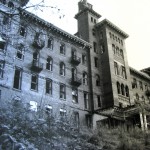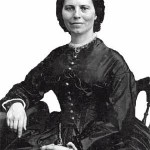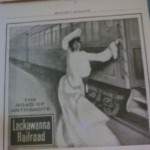 A long-abandoned, castle-like building, nestled in the hills just below an old railroad bed, looms over my hometown of Dansville, New York. Its vibrant red bricks stand out among the summer green, the autumn palette, the wintertime starkness, and the soft buds of spring.
A long-abandoned, castle-like building, nestled in the hills just below an old railroad bed, looms over my hometown of Dansville, New York. Its vibrant red bricks stand out among the summer green, the autumn palette, the wintertime starkness, and the soft buds of spring.
The Castle on the Hill, as it’s known to village residents, is steeped in as much history as it is eeriness. Ah, well, truth be told, it really isn’t all that eerie, except maybe around Halloween, when someone thinks perhaps a figure has just appeared in one of the now glassless windows.
The Castle on the Hill. Our Home on the Hillside. The Jackson Sanatorium. The Physical Culture Hotel. These are the various names and incarnations the six-story brick structure has taken on over the years.
It first came to prominence under the direction of James Caleb Jackson, a man plagued by ill health. Dr. Jackson took over the facility from Nathaniel Bingham, who’d originally established the health spa/water cure near a wellspring on the village’s East Hill.
Word spread quickly about the resort, and its unique focus on exercise, diet, and the curative properties of water. Our Home on the Hillside attracted a world-wide clientele, perhaps its most famous being one Clara Barton. It was during the time she was a resident of the facility that she founded the first chapter of the American Red Cross, at St. Paul’s United Lutheran Church in Dansville, at 21 Clara Barton Street. The church is still in use today.
The next time you’re enjoying granola, keep in mind that the popular health food had its roots in Dansville. Originally concocted by Dr. Jackson, he called his recipe Granula. When other versions appeared under the same name, Dr. Jackson successfully sued for infringement, and manufacturers substituted an “o” for the “u” in the name.
The popularity of the water cure slowly faded over time, and at the height of the Great War (World War I), the facility was converted into a military hospital.
The building shot to prominence again when eccentric health guru Bernarr Macfadden purchased the property in 1929. Macfadden was not only a health advocate and bodybuilder, but also a media entrepreneur, having established a magazine publishing empire, still in operation today (Macfadden Business Communications).
 Macfadden called his reincarnation of the facility The Physical Culture Hotel. For many years the robin’s-egg-blue billboard stood just above Route 256 and proclaimed that a stay there would be “The most glorious vacation of your life.”
Macfadden called his reincarnation of the facility The Physical Culture Hotel. For many years the robin’s-egg-blue billboard stood just above Route 256 and proclaimed that a stay there would be “The most glorious vacation of your life.”
For many people it may well have been, at least until 1955, when the building closed its doors. Since that time, it’s stood empty (except for a brief re-opening of the first floor in the early 1970s, as a failed bakery). It’s suffered much decay and vandalism over the years. Still, there’s hope one day something might come of it, as the property has recently been awarded a preservation grant from New York State.
Until that time, the Castle on the Hill will remain a reminder of Dansville’s history, a beautifully haunting presence of what once was. And it gives any Dansvillian the opportunity to boast that he or she comes from the only village in New York’s Southern Tier that has a storybook castle in the hills high above town.
When I was a kid, the railroad bed above my hometown of Dansville, New York, was nothing but long path of gravel that ran the length of East Hill and beyond, through farmland and past abandoned depots in the small towns that were once served by the Delaware, Lackawanna and Western Railroad (the “DL&W”).
It was a great area for hikes. I used the location several times to make some non-Oscar-worthy Super 8 films with my siblings, cousins and friends acting as both cast and crew.
Sadly, a cell phone tower now occupies a prominent swath of East Hill, and the old bed is now posted.
In the late 1800s and early 1900s, coal-burning passenger trains stopped regularly along this route, often picking up and dropping off guests of the water cure facility nestled on the hill. Many passengers likely arrived with soot on their clothes, from powerful the locomotives.
But in the early 1900s, the DL&W began burning a cleaner type of coal, called anthracite. This allowed passengers to travel without the dirty and dusty side-effect of burning coal. To promote this new version of clean rail travel, a man by the name of Earnest Elmo Calkins created a fictional character named “Phoebe Snow,” who was shown in print ads dressed in a flowing white dress. The dress stayed sparkling clean, of course, thanks to anthracite. Thus, Phoebe was delighted to travel from Hoboken, New Jersey to Buffalo on “The Road of Anthracite”:
“Says Phoebe Snow
about to go
upon a trip to Buffalo
My gown stays white
from morn till night
Upon the Road of Anthracite”
A “next generation” of The Phoebe Snow, as the Hoboken to Buffalo train was called, was introduced in 1949 and ran until 1962. Residents of Dansville would regularly hear the rumble of the train up in the hills. When my mother and my aunt were in their late teens and early twenties, they would often take the Phoebe Snow to New York, for a weekend on the town. My father’s senior high school class trip to Washington, DC, began by boarding the Phoebe Snow, and then changing trains in Hoboken.
There are remnants of the railroad to be found in several of the Southern Tier towns that Phoebe Snow once served. Depots (some restored, some decaying), at-grade crossing signals on country roads, some rails and spikes still present but rusted. It’s a different atmosphere for us today, walking along those abandoned tracks, a haunting and empty reminder of once was. But for passengers on the Phoebe Snow, they enjoyed watching the countryside drift past, with its lush green hills, rolling farmland, and numerous gorges and waterfalls. What a difference just a few decades can make.
The Phoebe Snow gets a brief mention in my novel, Wellspring, when our protagonist—Aiden Royce—shares a first class rail car from Boston to New York in 1933. His chatty passenger informs Aiden that he’s continuing on to Rochester once they reach New York City. And this man proudly announces he’ll be taking “The Road to Anthracite.”
Yes, smart travelers knew how to avoid the soot.
–
Barry Brennessel’s novel Wellspring was inspired by the historic water cure facility that sits above his native village of Dansville, New York. For more information, visit his website at www.barrybrennesel.com .
**********
 When Barry’s first collection of stories was read aloud by his second grade teacher, the author hid. As the years flew by, he wrote more, hid less (not really), and branched out to Super 8 films and cassette tape recorders. Barry’s audience—consisting solely of friends and family—were both amused and bemused.
When Barry’s first collection of stories was read aloud by his second grade teacher, the author hid. As the years flew by, he wrote more, hid less (not really), and branched out to Super 8 films and cassette tape recorders. Barry’s audience—consisting solely of friends and family—were both amused and bemused.
Tinseltown, a Finalist in the 24th Annual Lambda Literary Awards, is Barry’s first novel. His novel The Celestial won the Gold Medal in the 2012 ForeWord Book of the Year Awards and was a Finalist in the 25th Annual Lambda Literary Awards. Reunion, a collection of linked stories, was a Finalist in the 2012 ForeWord Book of the Year Awards. A Special Kind of Folk and Paradise at Main and Elm are Finalists in the 2013 ForeWord Book of the Year Awards.
When not embroiled in his own writing, Barry sips wine, nibbles on chocolate, and watches films and TV—both the classic and the cheesy. (Mmm…cheese!)



Thanks for the interesting history lesson! 🙂
Hi Barbra,
You bet! And there won’t even be a quiz on any of the material. 🙂